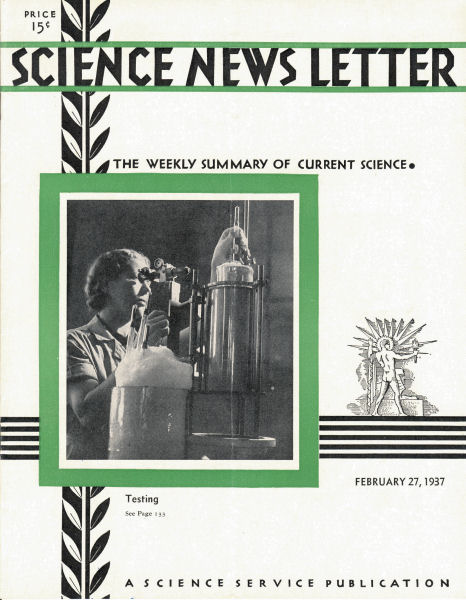From the February 27, 1937, issue

DEEP SEA THERMOMETERS TESTED BY UNCLE SAM
By checking the accuracy of deep-sea thermometers, Miss Grace Gowens of the Bureau of Standards aids the scientist to determine accurately the temperature of the sea at great depths. The freezing point of the thermometer is determined with the apparatus shown in the picture on the front cover of this week’s Science News Letter. The thermometer is placed in the ice for half an hour and then turned quickly, or “flipped.” The “flipping” causes the mercury column to break at a constriction and registers the temperature until disturbed. Melting ice has a temperature of 0° C. (32° F.) and is, therefore, a good standard.
NEW RADIO BALLOON INSTRUMENT MEASURES THICKNESS OF CLOUDS
Increased safety for aviation is seen in the newest development of the National Bureau of Standards. It is a new device that enables scientists on the ground to learn the height of the clouds, their thickness, and the altitude to which an airplane must climb to come out “on top,” as the pilots call it. H. Diamond, W.S. Hinman Jr., and F.W. Dunmore of the Bureau’s Radio Division have cooperated in the development of the instrument at the request of the United States Navy.
Moreover, the device can be used to learn the wind velocities above or within clouds, which conceal the upper sky, as well as to indicate the temperature and humidity of the air for altitudes up to nearly 12 miles.
The new equipment of the Bureau is an improved type of radio meteorograph; a tiny balloon bearing aloft a small radio transmitter that has characteristic signals for temperature, humidity, and altitude. These signals are received and recorded automatically on instruments on the ground.
Previous radio meteorographs have operated the switching mechanisms by clockwork devices or by a small electric motor that needed a battery to run it. The new design operates entirely without external power and uses the power of varying barometric pressure, as the balloon rises, to accomplish the switching.
LITTLE-KNOWN MINERAL TO FIND WIDE USE
Few people ever have heard of the little-known, little-used lithium mineral called spodumene, but through a process which U.S. Bureau of Mines experts described the mineral may soon help cool your home, improve the dishes from which you eat, better the production of lithia water you may drink, help start your motor car, and make a special, extratough glass.
At the annual meeting of the American Institute of Mining and Metallurgical Engineers, Oliver C. Ralston and Foster Fraas, of the bureau’s scientific staff, told of the simple method by which spodumene can be separated from other minerals with which it is associated in nature. Lack of use of the mineral has, in the past, been due to the absence of such a separating process.
Heating the mineral in a lime kiln, it has been found, reduces the spodumene to a chalky white mass that can be crumbled in the fingers while the remaining minerals in the ore remain strong.
The fine dust resulting from this treatment is about 80 to 90 percent pure, and from many localities this product will be of acceptable purity. It is much better adapted to use in making lithium chloride than the original hard, dense spodumene. It is also ready to be used in a glass batch, unless nature happened to put magnetic iron minerals in the ore, in which case a preliminary removal of iron minerals would be needed. The pottery makers have desired to use spodumene, but it has been unacceptable because of the fact that at the temperature of a kiln it tended to expand and tear pottery to pieces. The beta spodumene formed by the heating and now to be sifted out of the heated ore has already been expanded and does not have this disadvantage. Therefore potters are urged to forget ordinary spodumene and to try beta spodumene.
Spodumene is the most plentiful of the lithium-bearing ores. It looks much like feldspar and behaves like it. Lithium and lithium salts, heretofore extracted from less common and more expensive ores, now promise to have several important new uses. Lithium chloride solutions, for instance, should find greatly increased use in the conditioning and drying of air in the fast-growing air-conditioning industry.







